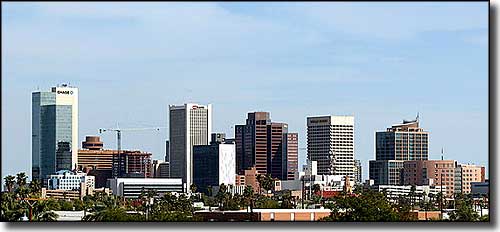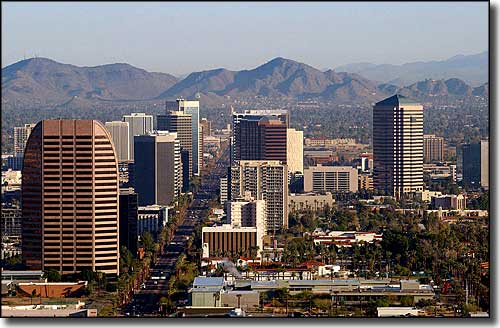
Phoenix, Arizona

In the heart of Downtown Phoenix
One of America's largest cities by land area, Phoenix is also the 5th most populous city and major anchor of the 12th most populous metro area in the country. As Phoenix is located in the northeastern reaches of the Sonoran Desert, the city also "enjoys" the hottest climate of any major city in the U.S.: for 3 months of the year, average high temperatures run above 100°F.
The first settlers in the Phoenix area were the Hohokam people. They built an extensive system of irrigation canals in the area (about 135 miles in total length), but between 1300 and 1450 CE, climate change brought enough periods of drought and severe flooding to convince the Hohokam to abandon the area. While most of the Hohokam basically disappeared, a few Akimel O'odham settlements on the Gila River show signs of having been occupied by their descendants. The Gila River area is also shared by the Tohono O'odham and Maricopa peoples.
The first European to visit the area is thought to have been the Italian Jesuit Father Eusebio Kino (in service to Spain). He named the Rio Salado (Salt River) for its high mineral content but he didn't do much else in this area, his focus was mostly on the Pima settlements and the missions he'd established there in southern Arizona. After his visit, the Valley of the Sun was essentially unpopulated for a couple hundred more years.
The first European settlement in what is now Maricopa County was Wickenburg, founded in 1863 to house and service gold miners in that local region. The next real settlement of people in the area came with the establishment of Fort McDowell on the Verde River, on the east side of the valley. The Hispanic workers who helped build Fort McDowell settled in to a camp on the south side of the Salt River by 1866. Over the years, this little settlement merged with others nearby and became the City of Tempe, but that was well after Phoenix was established and incorporated.
In 1867, a former Confederate soldier named Jack Swilling came into what is now the Phoenix area and saw a vision of the Valley of the Sun filled with irrigated croplands. What fueled his vision was the presence of the ruins of the Hohokam constructions, especially their irrigation canals. He hired men and had those old canals rebuilt. Then he began promoting and selling the area. The Town of Phoenix was officially recognized by the Board of Supervisors in Yavapai County on May 4, 1868. By 1870, the total population in the valley was recorded by the US Census at 240. In 1870, the townspeople bought a 320-acre piece of land and dedicated that to building the Phoenix Civic Center. That area is today located in the very heart of downtown Phoenix.
Maricopa County was created out of the southern half of Yavapai County in 1871, and Phoenix was the natural county seat. In the county office' elections held that year, 3 men ran for county sheriff. By the time voting day finally rolled around, Candidate Jim Favorite had been shot and killed by Candidate John Chenowth, who then withdrew himself from the race, so Candidate Tom Barnum ran unopposed and became Maricopa County's first illustrious sheriff.
The 1880 Census recorded the population centered around Phoenix at 1,708, in 1890 at 3,152. In those years, Phoenix was incorporated as a city and the territorial government was brought there in 1889. The railroad also arrived in those years and Phoenix became a major trade center. The city even had its own electric streetcar system running in 1891.
President Theodore Roosevelt signed the National Reclamation Act in 1902. That Act of Congress allowed for the construction of dams on many western rivers for the purposes of power generation, flood control and crop irrigation. One of the first projects begun under that new act was Roosevelt Dam on the upper Salt River. Over the years other dams have been built and lakes created downstream from Theodore Roosevelt Lake and east of Phoenix. The water and power generated by the dams all flow to Metro Phoenix and have provided the impetus to first turn the Valley of the Sun into fertile farmland, then into the growing metropolis it has now become.
Arizona was given statehood with Phoenix as the state capital by President William Howard Taft on February 14, 1912. World War II brought prosperous years to Phoenix as the city became a center for pilot training, with a larger area for infantry training to the west of town. Phoenix quickly grew into a military supply manufacturing and distribution center. The area where Papago Park and the Phoenix Zoo are now was also developed then into a Prisoner of War Camp for captured German soldiers.
The Phoenix Metropolitan Area has seen continued significant growth right up until the sub-prime mortgage crisis started to unfold and so many recent home buyers in the area took a severe financial hit: the median value of a home in the Valley of the Sun has dropped to about 60% of what it had been previously. The housing market was flooded with foreclosures. For the first time since its founding, Phoenix may actually be seeing a decrease in population...

The Phoenix Skyline (2007)

The view north on Central Avenue in 2004

View of Phoenix from the North Mountain Preserve
Zip Codes: 85001-85041, 85043-85046, 85048, 85050, 85051, 85053-85055, 85060-85080, 85082, 85085, 85097-85099
Latitude: 33.4485°N
Longitude: 112.0738°W
Incorporated: February 5, 1881
Elevation: 1,117'
Education:
High School or Higher: 76.6%
Bachelor's Degree or Higher: 22.7%
Graduate or Professional Degree: 7.6%
2011 Cost of Living Index for Phoenix: 92.7
Estimated Median Household Income: $47,100
Estimated Median Home Value: $182,300
Median Resident Age: 30.7 Years
Major Industries:
Lodging & Food Services, Construction, Health Care, Waste Management Services, Educational Services, Professional Services, Finance & Insurance Services, Government
Unemployed (March 2011): 10.0%
2010 Population Demographics
| Total Population | 1,445,632 |
| Males | 725,020 |
| Females | 720,612 |
| Population by Age | |
| Under 18 | 408,341 |
| 18 & over | 1,037,291 |
| 20-24 | 106,757 |
| 25-34 | 224,128 |
| 35-49 | 307,923 |
| 50-64 | 232,626 |
| 65 & over | 121,943 |
| Population by Ethnicity | |
| Hispanic or Latino | 589,877 |
| Non Hispanic or Latino | 855,755 |
| Population by Race | |
| White | 951,958 |
| African-American | 93,608 |
| Asian | 45,597 |
| Native American | 32,366 |
| Hawaiian or Pacific Islander | 2,555 |
| Other | 267,214 |
| Two or more | 52,334 |
